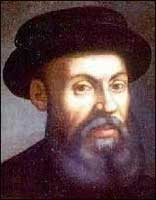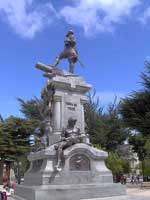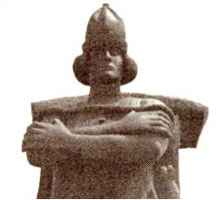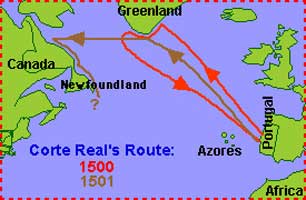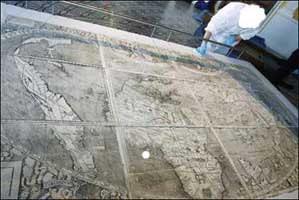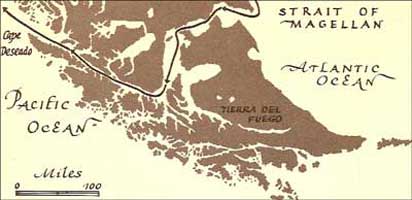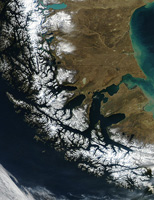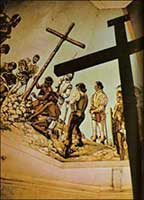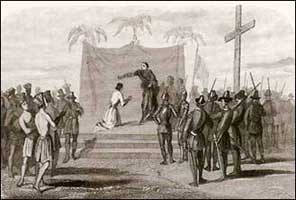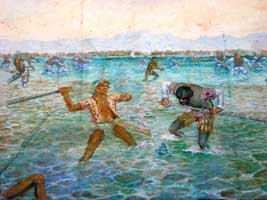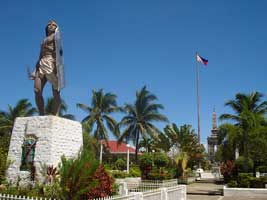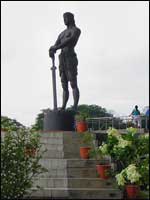Magellan had copies of ancient maps that showed a strait running from the Atlantic to the Pacific Ocean. After killing John Cabot, the Portuguese stole all his maps.
Ferdinand Magellan is credited with discovering a route into the Pacific Ocean which was named the Strait of Magellan in his honor. Fernão de Magalhães (Portuguese) Hernando de Magallanes (Spanish) was born in Portugal in the year 1468. He was a member of the Portuguese nobility and served as a minor functionary in the king's Court. He is never mentioned in the Portuguese records until 1505 when he signed on as a soldier under Dom Francisco d 'Almeida who was leading a 21 ship expedition of plunder to India. In 1512, he returned to Lisbon, still undistinguished, having never commanded or piloted a ship. In 1514, he applied to his sovereign, King Manuel I of Portugal, for a command of ships to visit the Spice Islands, in the Pacific Ocean. The king rudely refused, and told him very impolitely to "get lost." At the king's rebuke, Magellan decided to get revenge, and to offer his services to Portugal's bitter rival, Spain. He arrived in Spain on Oct. 20, 1517, and was welcomed as a hero!! Columbus and MagellanThere is a remarkable similarity between the careers of the so-called Christopher Columbus and Ferdinand Magellan!!
Portuguese failure Magellan was welcomed as a HERO in Spain!!What was it that turned Portuguese FAILURE Magellan into a hero in Spain? It was MAPS.....Top secret MAPS that the Portuguese did not want their bitter rival Spain to know anything about. When Columbus left Portugal, he had the TOP SECRET MAPS of Alonso Sanchez in his possession. He was able to find unknown islands with the maps. When Columbus returned in March, 1493, Spanish Pope Alexander VI gave the New World to Spain. The Portuguese were FURIOUS that the Spanish had outmaneuvered them. They threatened war and the next year (1494) the Treaty of Tordesillas was signed which divided up the entire world between Spain and Portugal. The Portuguese were given all lands to the EAST of the Treaty Line and the Spanish to the West. The Portuguese were very busy monopolizing trade and setting up forts in the Pacific before the Spanish found out about a passage to that ocean. When Magellan arrived in Spain, alarm bells began to ring back in Portugal. They did EVERYTHING they could to sabotage Magellan's fleet.
This demonic Portuguese killed the greatest mariner in the entire history of the world. Gasper Corte-Real left Portugal in May, 1500, heading straight for Newfoundland. Portuguese spies in Bristol and London kept King Manuel I minutely informed of the voyages of John Cabot. The Portuguese had plenty of practice in piracy as they raided the entire coast of Africa and India pillaging, destroying and making slaves of the native peoples. Everywhere Venetians sailors went, Portuguese pirates were not far behind to attack their ships and steal their goods. Here is an excerpt about the voyage of Corte-Real from the Venetian ambassador in Portugal to his brother in Venice:
Maps
were classified as top secret so the Portuguese and Spanish
had the death penalty for sharing maps with other nations.
The Cantino world map of 1502This Portuguese map stolen from Cabot is undoubtedly the first map to show the western continent with the Pacific Ocean. It was the forerunner of the Waldseemuller map of 1507.
This map was made after the return to Portugal of the Corte-Real expedition to Newfoundland. It shows the western continent as separate from Asia. The Portuguese passed a law forbidding any foreigner under pain of death from looking at their maps. An Italian named Alberto Cantino, Lisbon based agent of the powerful Italian Este family, managed to have the map smuggled out of Portugal. It also shows the line of the Treaty of Tordesillas running from North to South. This map was the forerunner of the Waldseemuller map of 1507. Magellan knew EXACTLY where the Strait was located!!Magellan has access to the king's archives and he saw the maps of the New World that John Cabot had made. He saw on the maps a Strait running across the southern part of the New World. That was the information that Emperor Charles V desperately needed to sail westward to the Pacific and challenge the Portuguese. No wonder the Portuguese had a fit when they found out.
Magellan knew exactly where the Strait was located. He never captained a ship in his entire life yet he was placed in charge of a 5 ship armada. The Portuguese sent 3 ships to intercept him but like Columbus he managed to evade them. Most of his captains hated him and gave him untold trouble on the voyage. He survived 2 mutinies, and finally, with the help of the map, reached the Pacific Islands. Magellan tried to get Philippine chief to worship the CROSS!!Cross worship was rampant in Europe before the blessed Reformation. Wherever Magellan went he set up the infernal CROSS idol and tried to get the native people to worship it. One chief refused to worship this image of the beast, and as a result, Magellan declared war on him and his tribe. This brave chief's name was Lapu-Lapu. Magellan set up a cross on the highest point in the island and commanded ALL to worship it.
Here is a quote from the diary of Antonio Pigafetta:
One chief refused to worship this image of the beast, and as a result, Magellan declared war on him and his tribe. This brave chief's name was Lapu-Lapu: The death of Magellan at the battle of Mactan in 1521After surviving 2 mutinies and countless storms, Magellan considered himself INVINCIBLE. When he reached the area that is today called the Philippines, he felt an overwhelming urge to convert the natives to Romanism and bring them under the Spanish yoke.
The brave Philippine Chief Lapu-Lapu resisted the demands of Magellan to convert to Romanism and worship the cross. The intelligent chief was not about to acknowledge a foreigner in far away Rome as his spiritual chief, or an emperor in Spain as his political chief. As a result, Magellan rolled out his BIG GUNS. He put on all his armor, fired his big guns, showed the chief his entire armory and told him that Spain was a superpower and his boss, Emperor Charles, ruled most of the world. The chief was not impressed, so Magellan prepared to invade his island and burn his village. After an hour of hand-to-hand fighting, Magellan was forced to retreat to the water's edge. The Spanish captains hated him, and failed to come to his rescue, and as a result, he was stabbed to death and his body chopped in pieces and fed to the fish. Gallant Chief Lapu-Lapu braved overwhelming odds and gave battle to Magellan. He is a role model to people everywhere in the world who will not accept conquest and occupation by a more powerful nation.
As a result of the defeat, most of the islanders reverted back to paganism. They took down Magellan's cross; broke it in pieces and reverted back to worshipping their own idols. Thus sadly ended the natives first encounter with what they were told was "Christianity." Vital Link Editor's Notes It is easy to understand now why the Jesuits NEVER had a Portuguese general. The Portuguese Marquis of Pombal was the first to demand their suppression by the Pope. The Jesuits do throw some crumbs to the Portuguese now and then because Fatima is located in Portugal! References Bergreen, Laurence. Over the Edge of the World. Magellan's Terrifying Circumnavigation of the Globe. William Morrow, New York, 2003. Cameron, Ian. Magellan and the First Circumnavigation of the World. Saturday Review Press, New York, 1973. Daniel, Hawthorne. Ferdinand Magellan. Doubleday & Co., Garden City, New York, 1964. Joyner, Tim. Magellan. International Marine Publishing, Camden, MD, 1992. Pigafetta, Antonio. The Voyage of Magellan. (Translated by Paula Spurlin Paige), Prentice-Hall, Englewood Cliffs, New Jersey, 1969. Parr, Charles McKew. Ferdinand Magellan, Circumnavigator, His Life and Exploration. Thomas Y. Cromwell Co., NY, 1964. Copyright © 2013 by Patrick Scrivener |
